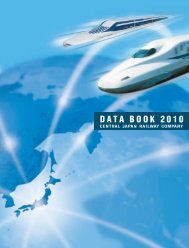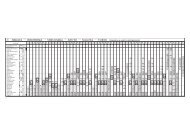CENTRAL JAPAN RAILWAY COMPANY Annual Report 2007
CENTRAL JAPAN RAILWAY COMPANY Annual Report 2007
CENTRAL JAPAN RAILWAY COMPANY Annual Report 2007
You also want an ePaper? Increase the reach of your titles
YUMPU automatically turns print PDFs into web optimized ePapers that Google loves.
Notes to Consolidated Financial Statements<br />
<br />
1. INCORPORATION OF <strong>CENTRAL</strong> <strong>JAPAN</strong> <strong>RAILWAY</strong> <strong>COMPANY</strong><br />
Central Japan Railway Company (Tokai Ryokaku Tetsudo Kabushiki Gaisha, the "Company") was incorporated on April 1, 1987, as a private business company, pursuant to<br />
the Law for Japanese National Railways Restructuring enacted upon the resolution of the Japanese Diet.<br />
The business of the Japanese National Railways ("JNR") was succeeded to by the following newly established organizations: seven railway companies including the<br />
Company, the former Shinkansen Holding Corporation (a predecessor entity to the Railway Development Fund (1997–1991), which was subsequently succeeded by the<br />
Corporation for Advanced Transport and Technology (the "CATT") (2003–1997) and in turn by the Japan Railway Construction, Transport and Technology Agency (the<br />
"JRTT") ), former Railway Telecommunication Co., Ltd., Railway Information Systems Co., Ltd. and the Railway Technical Research Institute. JNR itself became JNR<br />
Settlement Corporation (the "JNRSC"). All of the assets and liabilities of JNR were transferred to such organizations, including JNRSC.<br />
Prior to December 1, 2001, the Law Concerning Passenger Railway Companies and Japan Freight Railway Company (the "Law") required that authorization be obtained from<br />
the Minister of Land, Infrastructure and Transport (the "Minister of Transport") regarding fundamentals such as: (1) commencement of business other than railway and its<br />
related business, (2) the appointment or dismissal of representative directors and corporate auditors, (3) the issuance of new shares and bonds, (4) long-term borrowings, (5)<br />
amendments to the Articles of Incorporation, (6) operating plans, (7) sales of material assets, (8) appropriations of earnings and (9) merger or dissolution.<br />
As of December 1, 2001, since the Law was revised and the Company was no longer in scope of the Law, the Company was not required to obtain the aforementioned<br />
authorizations.<br />
On October 8, 1997, the Company's shares were listed on the Nagoya, Tokyo and Osaka stock exchanges in Japan. JNRSC, which held all 2,240,000 of the Company's<br />
outstanding shares prior to the listing, sold 1,353,929 shares in the initial public offerings.<br />
Pursuant to the Law for Disposal of Debts and Liabilities of JNRSC enacted in October of 1998, the Company's shares held by JNRSC were transferred to Japan Railway<br />
Construction Public Corporation (the "JRCPC").<br />
On October 1, 2003, the CATT and the JRCPC were fully integrated, pursuant to the Law of Japan Railway Construction, Transport and Technology enacted on October 1,<br />
2003, and designated as JRTT.<br />
On July 2005, the JRTT sold 600,000 shares of the Company.<br />
On April 5, 2006, the JRTT also sold its remaining 286,071 shares of the Company. As a result of this sale, all of the Company’s shares held by the JRTT were sold.<br />
2. BASIS OF PRESENTING CONSOLIDATED FINANCIAL STATEMENTS<br />
The accompanying consolidated financial statements have been prepared in accordance with the provisions set forth in the Japanese Securities and Exchange Law and its<br />
related accounting regulations, and in conformity with accounting principles generally accepted in Japan, which are different in certain respects as to application and<br />
disclosure requirements of International Financial <strong>Report</strong>ing Standards.<br />
On December 27, 2005, the Accounting Standards Board of Japan (the “ASBJ”) published a new accounting standard for the statement of changes in equity, which is<br />
effective for fiscal years ending on or after May 1, 2006. The consolidated statement of shareholders’ equity, which was previously voluntarily prepared in line with the<br />
international accounting practices, is now required under generally accepted accounting principles in Japan and has been renamed “the consolidated statement of changes in<br />
equity” in the current fiscal year.<br />
In preparing these consolidated financial statements, certain reclassifications and rearrangements have been made to the consolidated financial statements issued domestically<br />
in order to present them in a form which is more familiar to readers outside Japan. In addition, certain reclassifications have been made in the 2006 consolidated balance<br />
sheet, and in 2006 and 2005 consolidated statements of income, consolidated statements of changes in equity and consolidated statements of cash flows to conform to the<br />
classifications used in <strong>2007</strong>.<br />
The consolidated financial statements are stated in Japanese yen, the currency of the country in which the Company is incorporated and operates. The translations of Japanese<br />
yen amounts into U.S. dollar amounts are included solely for the convenience of readers outside Japan and have been made at the rate of ¥118 to $1, the approximate rate of<br />
exchange at March 30, <strong>2007</strong>. Such translations should not be construed as representations that the Japanese yen amounts could be converted into U.S. dollars at that or any<br />
other rate. Japanese yen figures less than million yen are rounded down to the nearest million yen, except for per share information and U.S. dollar figures less than thousand<br />
of U.S. dollar are also rounded down to the nearest thousand of U.S. dollar, except for per share information.<br />
3. SUMMARY OF SIGNIFICANT ACCOUNTING POLICIES<br />
a. Principles of Consolidation<br />
The accompanying consolidated financial statements as of March 31, <strong>2007</strong> include the accounts of the Company and its 30 (30 in 2006 and 2005) significant subsidiaries<br />
(together, the "Companies").<br />
Under the control or influence concept, those companies in which the Company, directly or indirectly, is able to exercise control over operations are fully consolidated, and<br />
those companies over which the Companies have the ability to exercise significant influence are accounted for by the equity method.<br />
Investments in two associated companies are accounted for by the equity method. Investments in the remaining unconsolidated subsidiaries and associated companies are<br />
stated at cost. If the equity method of accounting had been applied to the investments in these companies, the effect on the accompanying consolidated financial statements<br />
would not be material.<br />
The difference between the cost of an acquisition and the fair value of the net assets of the acquired subsidiary at the date of acquisition is fully amortized when incurred.<br />
All significant intercompany balances and transactions have been eliminated in consolidation. All material unrealized profit included in assets resulting from transactions<br />
within the Companies is eliminated.<br />
A consolidated subsidiary has adopted a fiscal year ending on February 28, which is different from that of the Company. The necessary adjustments for preparing<br />
consolidated financial statements as at the Company's year end was appropriately made, such as eliminating significant intercompany accounts and transactions which occur<br />
between the fiscal year end of the subsidiary and fiscal year end of the Company.<br />
b. Cash Equivalents<br />
Cash equivalents are short-term investments that are readily convertible into cash and that are exposed to insignificant risk of changes in value.<br />
Cash equivalents include time deposits, certificate of deposits and commercial paper, all of which mature or become due within three months of the date of acquisition.<br />
c. Inventories<br />
Merchandise is stated at cost principally determined by the retail method. Materials and supplies are carried at cost principally determined by the moving-average cost<br />
method.<br />
d. Land and Buildings Held for Sale<br />
Land and buildings held for sale are stated at cost determined by the specific identification method.<br />
41





